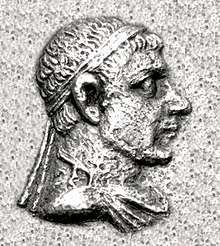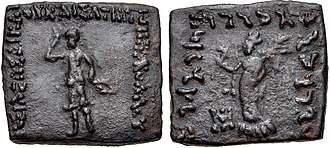Peukolaos
Peucolaus Soter Dikaios (Greek: Πευκόλαος ὁ Σωτήρ, ὁ Δίκαιος; epithets mean respectively, "the Saviour", "the Just") was an Indo-Greek king who ruled in the area of Gandhara c. 90 BCE. His reign was probably short and insignificant, since he left only a few coins, but the relations of the latter Indo-Greek kings remain largely obscure.
| Peukolaos | |
|---|---|
 Portrait of Peucolaos | |
| Indo-Greek king | |
| Reign | c. 90 BCE |

His name could be interpreted as "The man from Pushkalavati". Pushkalavati was the historic capital of Gandhara located in the Valley of Peshawar.
Coins of Peucolaos
Peucolaos struck rare Indian standard silver coins with portrait in diadem, and a reverse of a standing Zeus, which resemble the reverse of contemporary kings Heliokles II and Archebios. The latter has overstruck two coins of Peucolaos.
He also issued bilingual bronzes with Artemis and a crowned woman with a palm branch, perhaps a city-goddess or a personification of Tyche, the deity for good luck.
See also
Sources
- The Greeks in Bactria and India, W. W. Tarn, Cambridge University Press.
- The Coin Types of the Indo-Greek Kings, 256-54 B.C., A. K. Narain
References
- "Monnaies Greco-Bactriennes et Indo-Grecques", Osmund Bopearachchi, Bibliotheque Nationale, 1991, p.309
- Castro, Andrea (Angelo Andrea) A. A. Di. "Crowns, Horns and Goddesses Appropriation of Symbols in Gandhāra and Beyond": 38–39. Cite journal requires
|journal=(help) - O. Bopearachchi, "Monnaies gréco-bactriennes et indo-grecques, Catalogue raisonné", Bibliothèque Nationale, Paris, 1991, p.453
- Quintanilla, Sonya Rhie (2 April 2019). "History of Early Stone Sculpture at Mathura: Ca. 150 BCE - 100 CE". BRILL – via Google Books.
| Preceded by Amyntas Nikator |
Indo-Greek Ruler (in Arachosia, Gandhara) c. 90 BCE |
Succeeded by Menander II |
